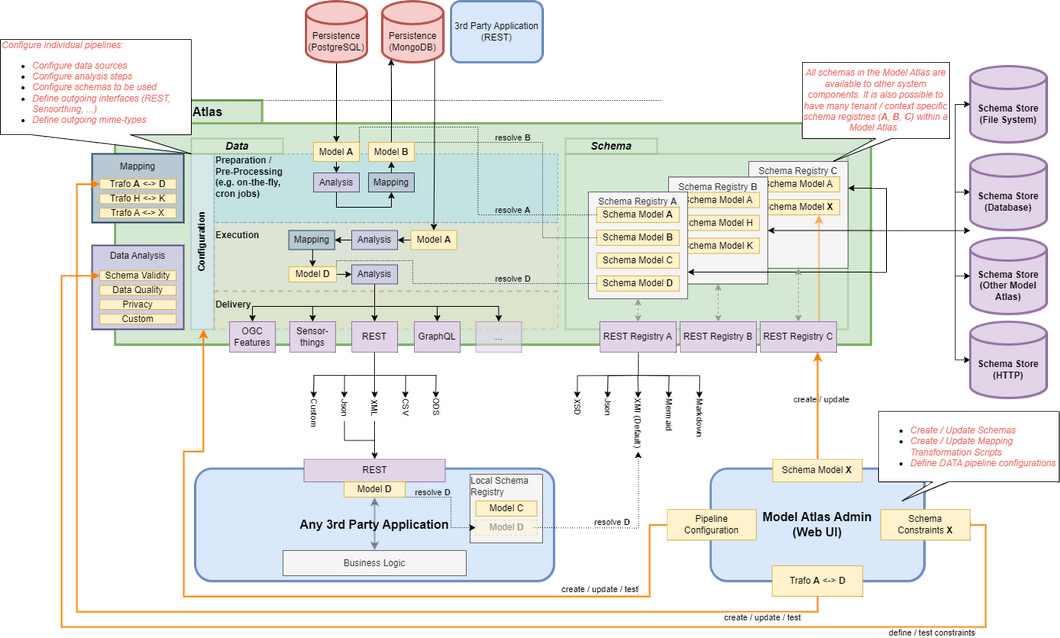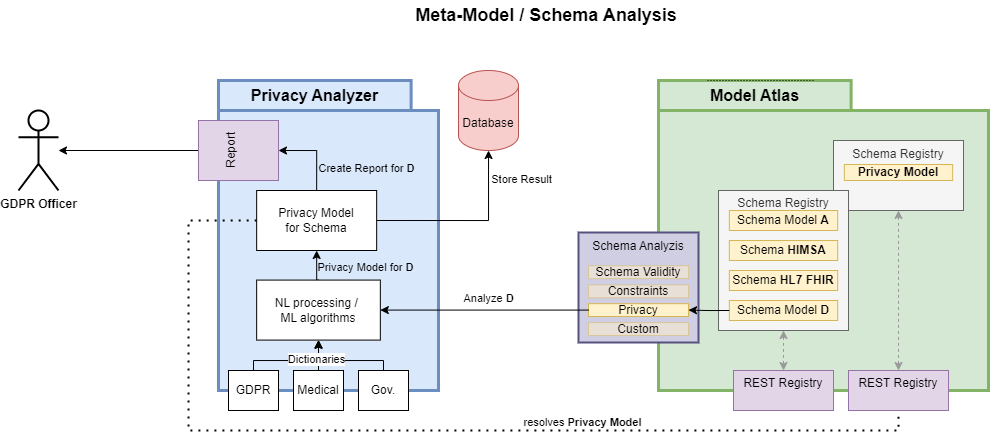Smart City
Urban Data Platform
Urban data platforms are at the heart of modern smart city infrastructures. As data hubs, they provide internal and external stakeholders with the data they need for their work or interests. Additionally, they enable comprehensive data queries in terms of data transparency, enable clear processing of data queries via dashboards and can thus become powerful tools for internal data management and increasing efficiency in entire process chains.
We offer a comprehensive solution for setting up data platforms - tailored to the requirements of smart city environments. Our architecture is based on the principles of modularity, expandability and open source. The core elements of our data platform architectures are the SensiNact data broker and a connected Model Atlas. As a service-oriented data hub, the data broker controls the collection and distribution of all integrated sensor data, while the model atlas ensures the readability and interoperability of a wide variety of data structures. Thanks to the modular and expandable structure, additional services (e.g. DCAT registry, document service, etc.) can be connected depending on the requirements or complexity level and scaled to the depth of the mapped data structures.
The result is a flexible smart city solution that is easy to maintain and - if desired - can be fully managed by the end user. It can be used independently of any system, does not create any additional dependencies, ensures maximum interoperability and prevents the creation of data silos through stringent modeling.

Figure: Schematic example configuration of the data broker for an urban data platform. The APIs can be extended and customized almost at will.

Figure: Schematic structure of the Model Atlas for usage in an urban data platform.
IoT Sensor Integration and Model-UI
Distributed sensors are the starting points of data streams and translate physical processes as data into digital applications. They are the cornerstone of countless smart city use cases.
We model existing sensor networks for integration into existing IT infrastructures or support the development of new sensor networks. In order to facilitate the modeling of data platform structures for the coordination offices and end users of our customers, we configure a Model User Interface that provides a low-code user environment. All common standards from the fields of environmental sensors, traffic or energy management such as KML, RDF, VDV (IBIS-IP), OCIT, NGSI (Fiware) or OGC (SensorThings, Features) are supported.
Smart Traffic Light System “ILSA”
With our Smart Traffic Signal System “ILSA”, we connect traffic light systems to smart city infrastructures. By using an easy-to-maintain hardware setup, we make traffic light switching phases and magnetic loop or push-button inputs readable and transferable in real time. This solution enables municipal operators to open up traffic light systems, which are often monolithic and equipped with proprietary software, for a variety of traffic control purposes, to collect traffic data in real time and to combine intelligent switching systems with the existing infrastructure without having to procure new traffic control technology.
Conflict Detection
We have developed a system with a resource-efficient hardware setup that can be used to detect conflicts in road traffic - especially at accident hotspots. By combining data from optical traffic detection sensors, signal systems and position sensors (e.g. from public transport vehicles), potential conflicts between road users can be predicted in real time. For example, if turning vehicles crossing a cycle lane with poor visibility receive a green traffic signal, the system can generate a warning for every cyclist approaching the junction, which can be played out in real time visually, acoustically or, in future, even integrated into smart driver assistance systems.
Data Protection
MPAT - Model Privacy Analyzing Tool
Organizations of all sizes must comply with data protection and data transparency regulations. These rules apply to a variety of areas within an organization, from contract design and database management to the actual production processes. This complexity often results in various isolated solutions spread across multiple systems, making it difficult to implement a coherent data protection and data transparency strategy.
As an innovative solution for technically supported data protection, we offer MPAT, a tool for digital reporting and for supporting decision-making regarding data protection measures that can be used regardless of the use case or organizational area. The tool uses the principles of our model-driven approach to analyze both data structures and data objects in order to examine them for data protection relevance in a context-sensitive manner. Data worthy of protection is identified and marked, and the results are then summarized in a privacy report. Depending on the use case, this data can then be automatically provided with an access restriction, anonymized or transferred into other data protection measures.
MPAT uses our Model Atlas technology, which serves as a knowledge database for recognizing different data models and structures. It is accessed by a dynamic learning algorithm that has been trained for specific applications to recognize data in different contexts and assess its relevance regarding data protection. The two-stage process is particularly innovative. In the first step, MPAT analyzes the schema in question in order to assess its data protection relevance. In the second step, however, it can also check all instances of the various schemas in order to verify the existence of protection-relevant data and identify additional data that has not yet been found in the schema analysis. The result is a powerful tool that is suitable both for supporting existing data protection and data transparency measures as well as for supporting the legal requirements of the General Data Protection Regulation in areas and use cases where no off-the-shelf solutions are yet available.

Figure: Stage 1 of the MPAT process for usage in medical databases.

Figure: Stage 2 of the MPAT process for usage with medical data.
Data Protection Service and Consulting
Data protection is a necessity wherever personal data is generated or processed. Advancing digitalization is accompanied by an increasing volume of data that must be secured and managed in accordance with data protection regulations.
We offer comprehensive consulting services in the area of data protection and GDPR to support our customers in this process. Our team of TÜV-certified data protection officers can advise you and your organization, support you in creating data protection concepts, point out potential pitfalls when handling data records, prepare you for audits or act as external data protection officers for your organization. We are also happy to support your organization’s data protection officers in their tasks or provide advice on all data protection issues in digital project contexts.